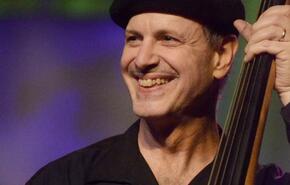About Mark
Anne Arundel County

Mark Schatz was born April 23, 1955 into a musical family. He began his formal musical training with cello at age ten and later switched over to string bass. His first performance was in 1971 on electric bass in a high school rock band. Inspired by a love for folk and traditional music, he started to play the guitar and mandolin.
From 1973 to 1978 Mark got his Degree in Music Theory and Composition from Haverford College, studied for a year at Berklee College of Music in Boston,… more
From 1973 to 1978 Mark got his Degree in Music Theory and Composition from Haverford College, studied for a year at Berklee College of Music in Boston,… more
Jump to a project:
Mark's Compositions
I started learning to play fiddle tunes when I was seventeen and had a crush on a gal who was into the folk and folk dance scene in the Boston area where I did most of my growing up. I told her I had a mandolin that I'd found in my grandfather's closet and she gave me Cole's 1001 Fiddle Tunes and circled a few tunes for me to learn. I had some facility because I'd been playing the cello since fourth grade so I picked up a flat pick and gave it my best effort. It didn't end up getting me much traction with the girl, but it did introduce me to the magic of a fiddle tune, each one a little world unto itself - beautiful melodies that are compact, symmetrical, generally with an A and B part that elegantly represent the yin and yang of musical form. I went on to get a degree in music and I studied fugues, sonatas, counterpoint and I appreciated the evolution and sense and beauty of these forms. But with my love of mandolin and clawhammer banjo it was fiddle tunes that I started to write in my mid-twenties. There is a variety of inspirations for these. When I sit around and play by myself it's generally a mixture of drills & exercises, tunes that I already know just for fun and sometimes to improve my playing of them, and sometimes it's just whimsical improvisation. Out of the latter a little melodic phrase may appear. I record this so I won't forget it, then let this phrase lead to another, always in search of that beauty of melodic shape that I loved in all of the traditional tunes that I had learned and played so many times. After completing a standard 8-bar A-part (which is generally repeated in a fiddle tune, sometimes with a second ending, sometimes without) I'd look for a contrasting beginning for a B-part, then let that lead me down a compelling path through the next 8-bars. I'd keep recording my progress so I wouldn't have to worry about forgetting something. Some folks might call this following the muse. I try to name the tune immediately after writing it so there is some organic connection to the moment. Full Moon is pretty obvious. Another is The Fallling Waters of Arden - I wrote that while out on my back deck with my sprinkler going back and forth, and the name of my neighborhood is Arden. All Full Up was written after a big meal. Chelsea Town was written while I was in London with Footworks, performing in the first London Run of Riverdance. I don't have a very good long-term memory so these tunes are almost like snapshots from my life, helping me stay connected with my past experiences.
Then there are tunes that I have written when feeling some emotion. All My Children emerged while I was watching a video of my younger brother playing with his young children in far off Israel where he lived at the time. I wrote Julie's Waltz after a dream I had of an old flame.
Another category is events. I wrote the Samolynn Waltz while selling hotdogs in downtown Nashville around 1982 for the wedding of friends Sam and Lynn Bush. I wrote Black Mountain Air for the wedding of some other friends who were married in Black Mountain, North Carolina. I wrote For Carol for a favorite aunt who had died.
After recording my first CD, Brand New Old Tyme Way on Rounder Records, I did occasional shows to promote the project. For one of these shows I hired Jim Hurst on guitar, Missy Raines on bass, and Casey Driessen on fiddle. There was an alchemy in this configuration that made my tunes really come to life and I did a good bit of touring with these wonderful musicians from 2000 to 2003 as Mark Schatz and Friends. It culminated with the recording of my second solo project, Steppin' in the Boiler House.
Included here is a selection of my compositions drawn from these two solo projects.
Then there are tunes that I have written when feeling some emotion. All My Children emerged while I was watching a video of my younger brother playing with his young children in far off Israel where he lived at the time. I wrote Julie's Waltz after a dream I had of an old flame.
Another category is events. I wrote the Samolynn Waltz while selling hotdogs in downtown Nashville around 1982 for the wedding of friends Sam and Lynn Bush. I wrote Black Mountain Air for the wedding of some other friends who were married in Black Mountain, North Carolina. I wrote For Carol for a favorite aunt who had died.
After recording my first CD, Brand New Old Tyme Way on Rounder Records, I did occasional shows to promote the project. For one of these shows I hired Jim Hurst on guitar, Missy Raines on bass, and Casey Driessen on fiddle. There was an alchemy in this configuration that made my tunes really come to life and I did a good bit of touring with these wonderful musicians from 2000 to 2003 as Mark Schatz and Friends. It culminated with the recording of my second solo project, Steppin' in the Boiler House.
Included here is a selection of my compositions drawn from these two solo projects.
-
Cajun StompCo-written with New Brunswick Fiddler, Ray Legere, this tune emerged with a wonderful cajuny feel, thus the name.
-
Black Mountain AireThis was written for two friends who got married in Black Mountain, North Carolina.
-
Season of JoyAs mentioned in this project's description, Casey Driessen played fiddle on most of the Steppin' in the Boiler House CD. But I had Stuart Duncan in as a special guest on a couple of numbers, and it was old friend, Bela Fleck's idea to do this one with twin fiddles - brilliant!
-
Steppin' In The Boiler HouseMy wife, Eileen Carson, and I taught at the Augusta Heritage Festival workshops in Elkins, West Virginia for many years. In one class where she was teaching clogging in the old boiler house I came up with this tune to have something fun and different for the dancers to do their newly learned steps to. The percussion on this one is hambone, a wonderful tradition of body percussion from the south, originally African American, that I learned from folks in Footworks who learned it from Frankie and Doug Quimby from the Georgia Sea Islands. When the dancers respectfully asked them if it was alright for them to include it in their shows and teach others, their reply was "Well you're Americans, aren't you?" This reminds me of a wonderful phrase that has encouraged me when I've wondered what I was doing playing bluegrass, blues, and other kinds of music that I love but did not grow up with: "The tradition does not care who bears it."
-
New Year's SongThis was written for my Father whose birthday was Jan 1. One of Nashville's most colorful percussionists, and a good friend, Kenny Malone joined me on this one. He's playing a weird ceramic drum that he built for himself. He called it Og, and there was a port in the top of it that he'd put his chin in and out of to change the tone of the drum. Odd and wonderful, like Kenny!
-
StogiesWhen I set out to record my first solo project, Brand New Old Tyme Way, which featured my original compositions on clawhammer banjo, I reached out to one of my bass heroes, Roy Huskey Jr to play bass on it. Bela, the producer, suggested we come up with a bass duet for the CD. In the middle of working up the number, we stepped out on the front stoop of my little house in East Nashville to partake in a couple of his tiparillos of which he was very fond. Thus the name!
-
The Falling Waters Of ArdenI wrote this one warm summer afternoon while sitting out on my back deck in Crownsville, Maryland, watching the sprinkler go back and forth. I used the name of the neighborhood I live in, Arden on the Severn, to name this sweet, lyrical melody.
-
CalgaryI wrote this while on a summer tour of Canadian Childrens Festivals with Footworks Percussive Dance Ensemble. We had been asked to do an early morning TV spot to help promote the festival in Calgary, Alberta, and although it was July, there was a Canadian chill in the air. The Footworkers were dancing to warm up and I started to play along and this tune emerged.
-
Samolynn Waltz-Gypsy DanceWhen I first moved to Nashville around 1982 it was a scratch and a scrape for a while, which led me to selling hotdogs out of a cart in downtown one hot summer. I would often bring my mandolin to pass the time before the busy lunch hour and in one of these lulls I wrote the Samolynn Waltz for the wedding of friends Sam & Lynn Bush. Oddly enough, Gypsy Dance was written on the banjo, but it worked out well to play it on mandolin as a nice pairing with the waltz. I love the mandolin though I don't get much opportunity to play it anymore, so it was nice to feature it on a few numbers on Brand New Old Time Way. I feel like these tunes evoke my Eastern European forbears.
-
Lennie's MisfortuneI wrote this around the time that my father, Leonard, was having a bit of minor surgery, thus the name. I later wrote a third part or "bridge" that was just a chord progression with no melody which provided harmonic contrast and freed up the band from the more restrictive nature of the fiddle tune to jam some. Jim Hurst and Casey Driessen took marvelous advantage of this while I stayed out of the way and provided just rhythmic and harmonic support.
